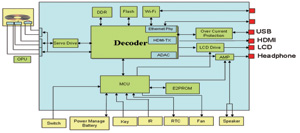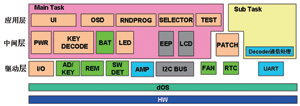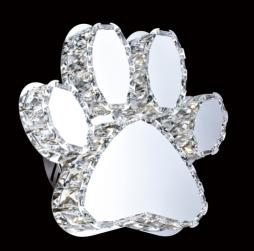At present, the gradual replacement of DVD players by BD players has become a trend. This trend will also extend to the field of portable disc players. At the 2011 CES show in the United States, Sony, Philips, Sumsung and others all launched their own portable BD players after Panasonic, which shows that this trend has taken shape. This paper elaborates the design and development content of portable BD player from the perspective of system solution. It aims to provide a solution and some ideas for domestic counterparts in designing products in the future, to avoid similar problems, improve development efficiency and improve products. Quality and competitiveness.
This article refers to the address: http://
The system hardware constitutes the whole system hardware structure as shown in Figure 1, including OPU, decoder, MCU, power battery management, button and remote control reception, LCD driver, HDMI output, USB, network interface, each Switch detection. The function of each configuration will be described in detail below.

Figure 1 system hardware components
OPU: Because BD players need to be compatible with DVDs and CDs, this module needs to be equipped with a laser head capable of reading CD/DVD/BD data. Currently, Sanyo, Sony and other products on the market can meet this requirement.
Decoder: The decoder of the BD player is required to decode 1920×1080P full HD video signals, including H.264/VC-1/MPEG, etc. MTK and Broadcom chips can meet the requirements. The decoding chips listed in this paper have built-in Ethernet, HDMI, ADAC and other chips with high integration. According to the needs of product development, the actual selection is specifically selected.
MCU: The role of the MCU is very important. Because of the many functions of portable players, there is currently no single decoder chip that can complete all portable functions in the market. Therefore, it is necessary to add a separate MCU to assist the decoder to form the whole system and realize all the functions of the system. The MCU is responsible for processing the buttons and the remote controller, controlling the driving chip of the LCD, power management, battery charging and discharging processing, audio power amplifier, etc., and simultaneously interacting with the decoder and transmitting information through communication between the two parties.
Battery power management: responsible for the power management of the entire system, including switching, adapter / battery switching, battery charging and discharging processing.
Buttons and remote control: handles the input of the body buttons and remote control buttons.
Switch: Responsible for the detection of external switches and headphone insertion.
RTC: Real-time clock module that can be used as an actual timing.
FAN: Fan, used to dissipate heat from the system; when the BD player is working, the chip has a higher operating frequency and higher power consumption, and requires an external device to dissipate heat to the main chip.
Over Current Protection: This chip is used to detect and protect the overcurrent of the USB interface.
USB: It is used for external USB devices, expands the functions of the CD player, and plays HD video playback corresponding to the network.
Network interface: There are three functions, (1) BD live playback that meets BDA requirements; (2) corresponding software network upgrade, BD player software is complex, and BD specifications are constantly updated, this function can be configured through the network after the product is released. The automatic upgrade function corresponds to market problems, meets the ever-changing needs of the market, reduces the input of consumers, and improves the competitiveness of products; (3) Corresponds to various network application functions.
The system software design system is mainly composed of a decoder and an MCU, and the decoder and the MCU cooperate and coordinate through communication to complete the functions of the entire system. Therefore, the software design of the system consists of three parts: the software design of the decoder part, the software design of the MCU part, and the communication design.
1 decoder software design decoder software is structured on the Linux operating system, including device drivers, middleware and application layers. Adopting a modular design concept, the system is divided into different levels and different modules according to system functions. The operation of different tasks is controlled by starting different processes.
The biggest difference between portable Blu-ray players and similar products in the past is that they can play Blu-ray discs and have rich network functions. The system structure of the decoder software is shown in Figure 2.

Figure 2 decoder software system composition
2 MCU software design
The MCU's software design uses a small operating system to manage two tasks. SubTask is used to communicate with the decoder. MainTask is responsible for all processing except communication. The whole system is divided into driver layer, middle layer and application layer. The driver layer includes hardware devices and OS, including terminal configuration, key input, switch detection, AMP, FAN, RTC, etc.; the middle layer contains various module interfaces that need to be provided to the application layer to implement specific functions and actions; the application layer is based on The functions of the system are divided into UI, OSD and other modules to complete various functions that the system needs to implement. The system structure of the MCU software is shown in Figure 3.

Figure 3 MCU software system composition
3 communication design
The communication between the MCU and the decoder, the physical layer can adopt a variety of interface forms, here is the UART. The design of the protocol layer requires a focus on two aspects. First, whether all the functions required by the system can be realized, and the errors that cause the system function to be affected due to the incomplete design of the protocol are not generated. Second, whether the communication exception handling mechanism is considered comprehensively, which affects the reliability of the system, including errors. The setting of the number of times of repeated transmission, the setting of the waiting delay time when the communication is busy, and the like.
Power Design Power design is important for portable products, taking into account not only the power consumed during normal operation, but also the power consumption during standby. Power consumption design involves many aspects of the system, including chip selection, circuit design and so on. Specifically, the system needs to study and verify the power consumption of the OPU part, the backlight of the LCD, the working power of the decoder, the peripheral circuits, and the power management during standby.
modern led crystal wall lamp, main material is stainless steel and Top K9 crystals. The light source is LED SMD . There are many different patterns and designs for customer to choose.
Wall lamp lighting should not be too large, so more artistic appeal, the choice of wall lamp shade should be based on wall color. In a large area of the same color background wall cloth, dotted with a prominent wall lamp, giving a sense of fresh and fresh.



Modern Crystal Wall Lamp,Crystal Wall Lights,Modern Lighting,Stylish Wall Lights
Laidi(Zhongshan) Lighting Co.,Ltd. , http://www.idealightgroup.com